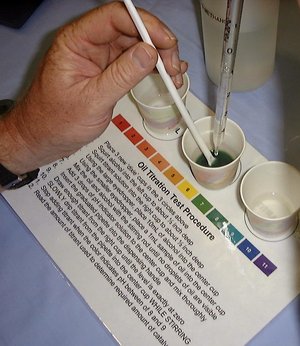How to make biodiesel
Posted by Krzysztof Lis on March 20, 2008
This article is a description of biodiesel making process. It will answer a very common question: how to make biodiesel fuel?
Biodiesel is made of vegetable oil. It can be a straight vegetable oil, found on a shelf in your local supermarket. It also can be a waste vegetable oil, used for frying fries. You can easily purchase full set of devices and tanks required for producing a biodiesel fuel.
To make biodiesel you need: vegetable oil, methanol and catalyst. As the catalyst you may use KOH (potassium hydroxide, known also as caustic potash, potassa, potash lye, and potassium hydrate) or NaOH (sodium hydroxide, know also as lye, caustic soda or sodium hydrate).
First you need to determine the acidity of vegetable oil. Oil from different batches may contain different amounts of free fatty acids. To make good biodiesel you need to know, how much catalyst you need to add, so you need to precisely determine the acidity of the oil. You take small amount of oil, and perform a litmus test. You will know the acidity of the oil and will be able to calculate the exact amount of catalyst to be used on your batch of vegetable oil. This part of biodiesel making process will be described here in more details in future.

The common proportion of all the stock needed to make biodiesel is: 1,000 liters (264 US gallons) of vegetable oil, 150 liters (40 US gallons) of methanol and 22 kg (48.5 lb) of KOH. This will produce 1,000 liters of biodiesel.
When you determine the proportions of biodiesel, methanol and catalyst, the process is somewhat automatic. You pour the vegetable oil to the biodiesel processor. You mix the methanol and catalyst (some biodiesel processors are able to mix those two substances automatically, in some cases you need to prepare the mixture by yourself). You add the methanol-catalyst mixture to the vegetable oil. You start the pump or whatever mixing device the processor is equipped with. The mixing process takes about an hour or so, depending on the processor.
After mixing, biodiesel needs to settle. The time required at this stage is close to 16-20 hours. The more time you give, the better fuel you get. This time is required for the glycerine to gather at the bottom of the tank. The glycerine is waste and needs to be separated from the biodiesel. Since glycerine’s density is greater than density of biodiesel, the most common way of separating those two substances is letting them settle and separate. You pour the glycerine in some tank and think of disposing it (I’ll post here an article on glycerine uses some time later). The proportion written above gives about 200 liters (53 US gallons) of glycerine.

At this time some biodiesel manufacturers wash the biodiesel. They wash it with water with some additive (helps to remove all the impurities from the fuel). You put the water into some closed tank with biodiesel inside, mix it thoroughly and let it settle. The water with all the impurities gathers at the bottom of the tank. You pour it somewhere and repeat the washing procedure until the water is clean. I posted a photo of biodiesel after first washing in article about biodiesel.
If you wash the biodiesel manually in some small batch, you may use a plastic bottle to do it. If you do it in your biodiesel processor, the process requires only some attention and is done automatically.
At this moment you may use the biodiesel fuel in your diesel engine. ![]()

If you’d like to see how biodiesel is made, take a look at the video on making biodiesel. ![]()
Comments
5 Responses to “How to make biodiesel”Leave a comment, and if you'd like your own picture to show up next to your comments, go get a gravatar!
i use Biodiesel on my car. i think everyone should use biodiesel so that each one can at least contribute to the environment.
On the measurements given above how much biodiesel would be available for motor vehicle usage?
I’m new to this, so please forgive if this question is of the ‘how long is a piece of string’ variety – Will the starting quality of the WVO affect the grade of the end-product?
Many thanks.
what should be the temp during the process of biodiesels
@Mark: it certainly will, but if you process the source the right way (e.g. remove the particles and water), you should get good quality biodiesel fuel.
@dhiraj: one can find different answers to such a question — from room temperature to something like 60-80°C.